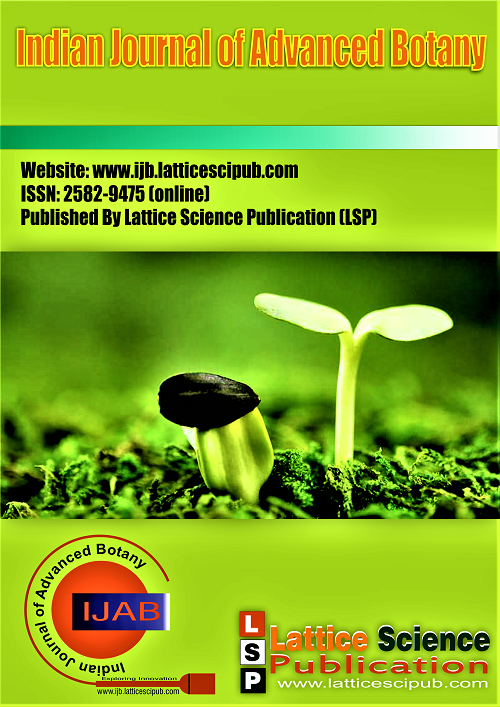Classified Plant Al-Dhahiriya in the South of Palestine
Main Article Content
Abstract
We studied plant species of Dhahiriya in the period between January to October 2021, and January to Jun 2024, due to the importance of plants in that vital part of Palestine, which is located in southern Palestine, including that region’s climate, and unique plants that represent of the Mediterranean region plants, North Africa, Sinai desert, Negev, Dead Sea, and Red Sea. It used the Braun-Blanquet (1979) method for the identification of plants. Moreover, Plants have been studied in Dhahiriya, located in southern Palestine. A total of 770 species from 70 families were identified, of which 86 (11.16%) are endemic. The plant families with the highest representation were Asteraceae (14.54%), Fabaceae (14%), Poaceae (7.41%), and Lamiaceae (5.19%). Regarding plant life forms, Therophytes account for 47%, Hemicryptophytes for 20.35%, Shrubs or Chamaephytes for 14.05%, and Trees or Phanerophytes for 9.05%, with a notable increase in spring.
Downloads
Article Details

This work is licensed under a Creative Commons Attribution-NonCommercial-NoDerivatives 4.0 International License.
How to Cite
References
Zohary M (1966). Flora Palaestina Volume II. Israel Academy of Sciences and Humanities, Jerusalem.
Zohary M (1972). Flora Palaestina. Part 2, Text Platanaceae to Umbelliferae. Israel Academy of Science and Humanities, Jerusalem 656. https://doi.org/10.1163/9789004630277
Ighbareyeh JMH, Suliemieh, AAA, Sheqwarah M, Cano-Ortiz A, Carmona EC (2022). Flora and Phytosociological of Plant in Al-Dawaimah of Palestine. Research Journal of Ecology and Environmental Sciences 2(1), 58– 91. Retrieved from https://www.scipublications.com/ journal/index.php/rjees/article/vie w/202 https://doi.org/10.31586/rjees.2022.202
Ighbareyeh JMH, Cano-Ortiz A, Cano E (2022a). Phytosociology and Vegetation of Plants of Beit Jibrin in Palestine. Land, 11, 264. https://doi.org/10.3390/land11020264
Ighbareyeh J, Carmona E (2018). A Phytosociological of Plant Communities and Biodiversity in the East-South of Idna Village-Hebron of Palestine. International Journal of Geosciences 9, 44-58. https://doi.org/10.4236/ijg.2018.91003
Palestinian Central Bureau of Statistics (PCBS) and the Environment Quality Authority Press Release on International Day for Biological Diversity: "Island Biodiversity"
Mayo, on 22, (2014). https://www.pcbs.gov.ps/post.aspx?lang=en&ItemID=1124
Ighbareyeh J, Cano-Ortiz A, Carmona E, Suliemieh A, Ighbareyeh M (2017). Flora Endemic Rare and Bioclimate of Palestine. Open Access Library Journal 4, 1-14. https://doi.org/10.4236/oalib.1103977
Ighbareyeh JMH, Cano-Ortiz A, Cano E (2021). Endemic plant species in the west of Hebron, Palestine. European Journal of Applied Sciences 9 (3). 368-385. https://doi.org/10.14738/aivp.93.10175
Ighbareyeh JMH, Cano-Ortiz A, Suliemieh AAA, Ighbareyeh MMH, and Cano E (2014). Phytosociology with Other Characteristics Biologically and Ecologically of Plants in Palestine. American Journal of Plant Sciences 5, 3104-3118. https://doi.org/10.4236/ajps.2014.520327
Katja Tielbörger (1997). The vegetation of linear desert dunes in the north-western Negev, Israel, Flora Volume 192, Issue 3, Pages 261-278, ISSN 0367-2530, https://doi.org/10.1016/S0367-2530(17)30792-2
Danin A (1986). Flora and vegetation of Sinai. Proceedings of the Royal Society of Edinburgh. Section B. Biological Sciences 89, 159-168. https://doi.org/10.1017/S026972700000899X
Danin A (2004). The inclusion of adventive plants in the second edition of Flora Palaestina Willdenowia 30, 305–314. https://doi.org/10.3372/wi.30.30209
Danin A (2004a). Distribution Atlas of Plants in Flora Palaestina Area, 2nd ed.; Academy of Science and Humanities: Jerusalem, Israel p. 520. ISBN 9652081671.
Danin A, and Feinbrun-Dothan N (1991). Analytical Flora of Eretz-Israel; CANA Publishing House Ltd.: Jerusalem, Israel.
El Hadidi MN, Hosni HA (1996). Biodiversity in the flora of Egypt. In: van der Maesen LJG, van der Burgt XM, van Medenbach de Rooy JM (eds) The Biodiversity of African Plants. Springer, Dordrecht. https://doi.org/10.1007/978-94-009-0285-5_101
Dothan FN (1978). Flora Palaestina, Part Three, Text Ericaceae to Compositae; Israel Academy of Science and Humanities: Jerusalem, Israel p. 481.
Dothan FN (1986). Flora Palaestina, Part Four Plates, Text Alismtaceae to Orchidaceae; Academy of Science and Humanities: Jerusalem, Israel, p. 525.
Chneeweiss Gerald M, Asgarpour Zahra, Moser Dietmar, Mahmoodi Mohammad, Sherafati Mahbubeh, Zare Golshan, Noroozi Jalil (2019). "Patterns of Endemism in Turkey, the Meeting Point of Three Global Biodiversity Hotspots, Based on Three Diverse Families of Vascular Plants". Frontiers in Ecology and Evolution. 7. doi:10.3389/fevo.2019.00159. ISSN 2296-701X https://doi.org/10.3389/fevo.2019.00159
Carmelo Maria Musarella, Salvatore Brullo, Gianpietro Giusso del Galdo (2020). "Contribution to the Orophilous Cushion-Like Vegetation of Central-Southern and Insular Greece". Plants 9(12), pg. 1678, https://doi.org/10.3390/plants9121678
Maria Panitsa, Panayiotis Trigas, Dimitrios Kontakos et al. (2021). "Natural and cultural heritage interaction: aspects of plant diversity in three East Peloponnesian castles (Greece) and conservation evaluation", Plant Biosystems -An International Journal Dealing with all Aspects of Plant Biology p. 1; https://doi.org/10.1080/11263504.2021.1889701
Jehad MH Ighbareyeh, Suliemieh AAA, Abu-Ayash AM, Sheqwara MN, Cano- Ortiz A, Cano-Carmona E (2021). Biodiversity and Phytosociological Analysis of Plants in Wadi Al-Quf Nursery Reserve North - Western of Hebron City in Palestine. Journal of Plant Sciences, Vol. 9, No. 1, pp. 13-24. https://doi.org/10.11648/j.jps.20210901.13
Ighbareyeh JMH (2024). Pear Production (Pyrus communis L.) in Jerusalem, Palestine. Asian Journal of Biology 20(5), 1–11. https://doi.org/10.9734/ajob/2024/v20i5401.
Pringle Denys (1997). Secular buildings in the Crusader Kingdom of Jerusalem: an archaeological Gazetteer. Cambridge University Press. ISBN 0521-46010-7.
Braun-Blanquet J (1979). Fitosociología. Bases para el estudio de las comunidades vegetales. Blume, Madrid p. 820.
Van Der Maarel E (1979). Transformation of Cover-Abundance Values in Phytosociology and Its Effects on Community Similarity. Vegetation 39, 97-114. https://doi.org/10.1007/BF00052021
Ali-Shtayeh MS, Jamous RM (2018). Updating the plant “Red List” of Palestine (West Bank and Gaza strip): Conservation assessment and recommendations. J. Biodivers Endanger species 6: 224.
Ali-Shtayeh MS, Salah Ayman MA, Jamous RM (2003). Ecology of hymexazolin sensitive Pythium species in field soils. Mycopathologia 156: 333-342. https://doi.org/10.1023/B:MYCO.0000003561.47451.f7
Gangadharan, K., Kumari, G. R. N., & Dhanasekaran, D. (2019). Classification and Functional Analysis of Major Plant Disease using Various Classifiers in Leaf Images. In International Journal of Innovative Technology and Exploring Engineering (Vol. 9, Issue 2, pp. 4240–4248). https://doi.org/10.35940/ijitee.b6332.129219
R, R., & S H, M. (2021). Plant Disease Detection and Classification using CNN. In International Journal of Recent Technology and Engineering (IJRTE) (Vol. 10, Issue 3, pp. 152–156). https://doi.org/10.35940/ijrte.c6458.0910321
V., G., Dr., CK, G., Dr., Reddy, Y. P., Ms., & V., H., Ms. (2021). The Weed Plant Detection. In International Journal of Engineering and Advanced Technology (Vol. 10, Issue 4, pp. 206–209). https://doi.org/10.35940/ijeat.d2454.0410421
E.L. Pankratov. (2024). On Prognosis of Growth of Plants During Control by Lighting. In Indian Journal of Advanced Botany (Vol. 4, Issue 1, pp. 1–3). https://doi.org/10.54105/ijab.a1026.04010424





